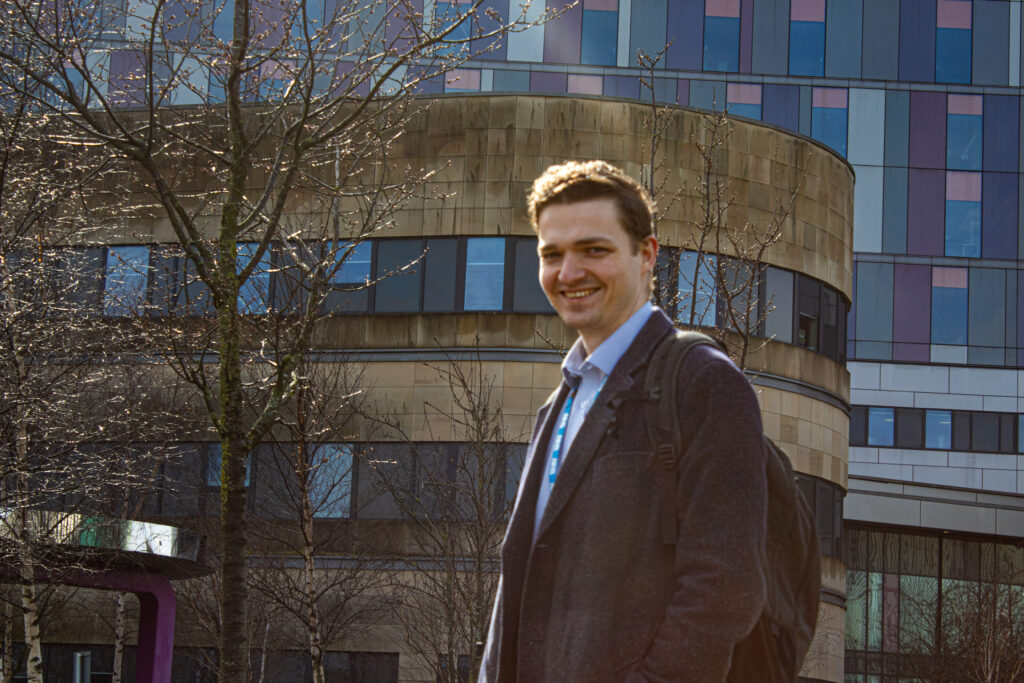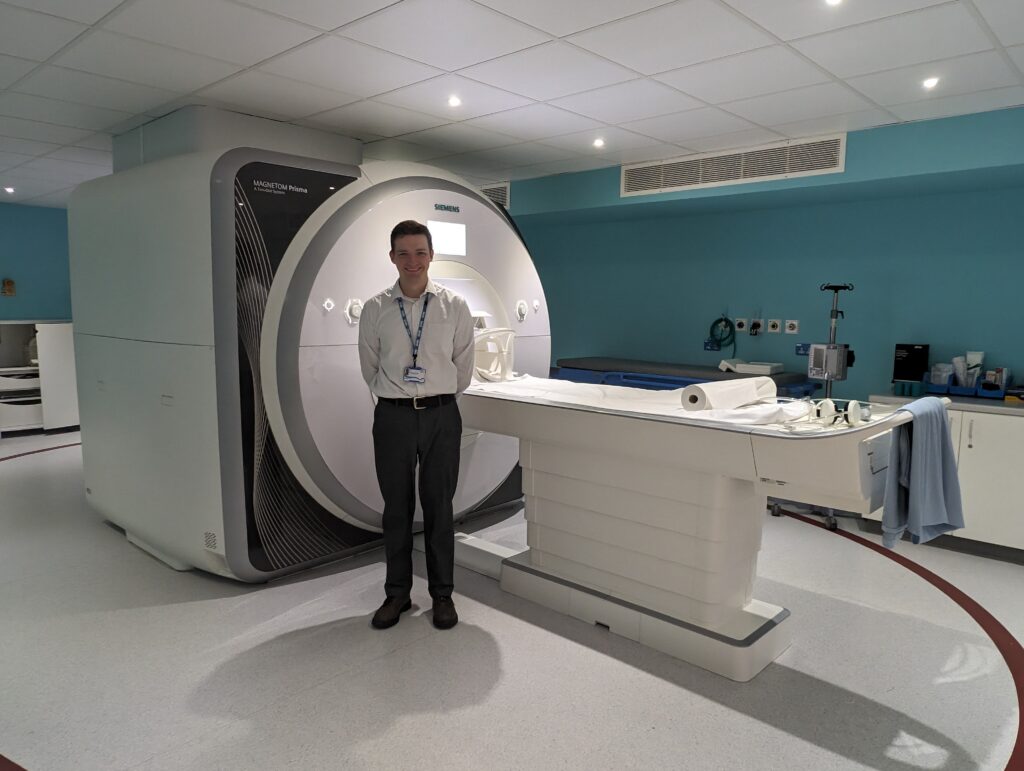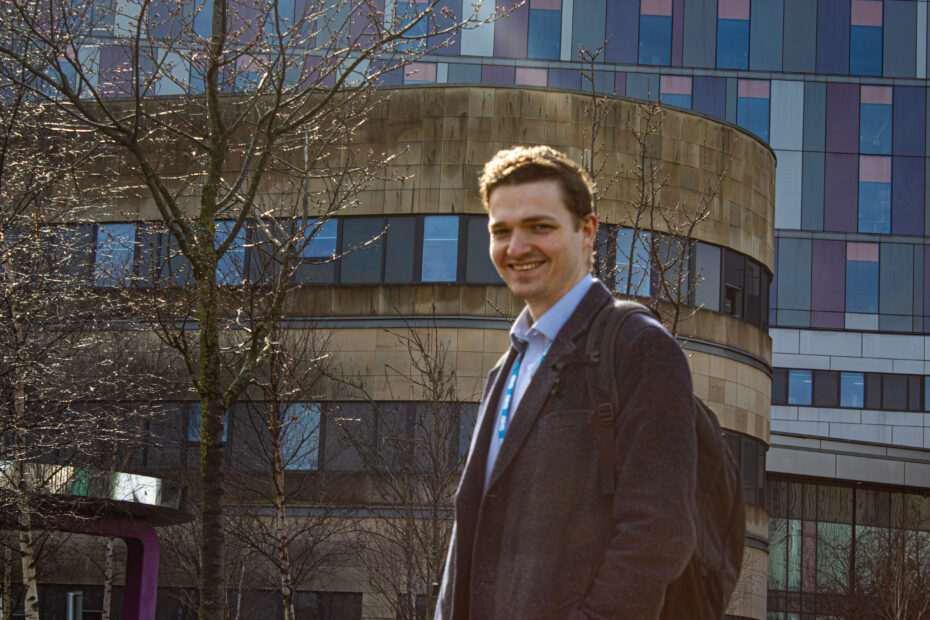
It’s like a plot line from a hit TV medical drama – a teenage boy is taken to hospital in excruciating pain but, despite all the tests performed and all efforts of medical teams, he doesn’t get better. But, just as his parents are told to prepare to say their goodbyes, a quick-thinking consultant and a sharp-eyed radiographer save the day.
This is exactly what happened to George Bruce when he was 15 – and the process of check and diagnosis, the discipline of the people who cared for him, is what inspired him to study science at university, and become a Clinical Scientist specialising in MRI Physics.
“One evening I had a terrible pain in my stomach and my mum and dad rushed me to A&E,” said George, who is now 28 and works at the Queen Elizabeth University Hospital. “They took blood and I was given X-ray, CT and MRI scans, but nobody knew what it was.
“They repeatedly asked if I’d taken drugs or had swallowed anything sharp, even asking if my parents had been abusive. They made notes of how often my parents visited or enquired about my condition.”
By now George was very ill, and spent two weeks in hospital, where his parents were told to prepare for the worst.
“But then,” he went on, “the consultant asked for an ultrasound and during that the radiographer spotted something unusual.
“I underwent surgery – and it was that that saved my life.
George had Meckel’s Diverticulum with intussusception – “an abnormality of the small intestine, which can look like a second appendix,” he said – which is when a small pocket forms in a patient’s intestine. It’s very rare and usually harmless, but in a very small number of cases it flares up, and that’s what caused the problems that George suffered from.
George, who now lives in Uddingston, puts just how rare into context. “Only 2% of the population have one of these pockets. Of those, just 2% will develop complications as a consequence of their Meckel’s, most commonly before two years of age. My understanding is that only 2% of symptomatic cases occur in people as old as I was.”
So the odds of this happening were 1 in 125,000 – or just eight in every million people.
George was a child who always wondered how things worked, and his initial dream was to become a doctor. But after his illness, he realised that wasn’t for him and he was drawn more towards science.

“During my A-levels my teacher highlighted medical physics as a career, and because of the diagnosis process that helped me, I became interested in doing physics at university – in fact, that interest became dogged determination after my teacher told me I wouldn’t be able to do it.”
In his third year at university, George attended a talk on MRI physics, and from then on his path was clear.
“I became fascinated by the challenges of getting images from inside a body,” he said.
“You see, X-ray is relatively easy to understand – you’re effectively ‘shining a torch’ into someone to see what you can see.
“Then there’s CT, which is more complicated. It involves taking multiple X-rays around the body, producing more detailed information about the inside of the body.
“There are a variety of other imaging techniques clinical scientists are involved in, such as ultrasound and nuclear medicine, but my chosen specialism was MRI
“MRI works by resonating the hydrogen atoms [H] in the water [H2O] within the body using radio frequencies, inside a very strong static magnetic field, to produce a highly detailed image.
“It’s complicated and convoluted – basically I feel as though I’ve landed at the most confusing end of the scanning story, and I love it.”
George has been doing his current job for five years – and every day is a completely new challenge.
“It would be quite difficult to describe a typical ‘day in the life’ of an MRI Physicist. Our day-to-day varies a great deal based on clinical need, planned developments, teaching and MRI safety concerns. It’s great to have a job that offers such variety.”
And since taking up his position, George has developed an equal passion for inspiring others to choose a career in health care science. He’s worked as a STEM Ambassador, going into schools and colleges and telling others about his role.
“I really enjoy telling the story of what I do. I want to show a young person like me, who’s not sure where their interest in science will take them, that there are brilliant, interesting, confusing careers out there.”
To find out more about Health Care Science and MRI physics, go to https://www.healthcareers.nhs.uk/explore-roles/healthcare-science or https://www.ipem.ac.uk/

